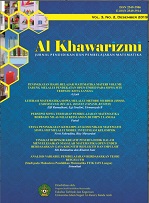ANALISIS VARIABEL PEMBELAJARAN BERDASARKAN TEORI REIGELUTH (Studi pada Mahasiswa Pendidikan Matematika FTIK IAIN Langsa)
DOI:
https://doi.org/10.22373/jppm.v3i2.7354Keywords:
learning variables, reigeluth theoryAbstract
Learning is an attempt to compare what behaviors might occur before individuals are placed in learning situations and what behaviors can be demonstrated after being given treatment. The purpose of this study was to analyze the learning variables according to teroi reigeluth which were divided into 3 things, namely (1) learning conditions, (2) learning methods and (3) learning outcomes. Subjects in this study were students of Mathematics Education Study Program FTIK IAIN Langsa in semester IV unit 1 who took courses in calculus and probability theory. By using descriptive analysis the results and research findings obtained in the form of learning conditions (learning objectives and characters, learner characters, and constraints in learning) for both courses namely calculus and opportunity theory give different results. Fundamental differences related to the two materials provide a finding that students are lacking in reasoning and sharpening their thinking power both through reading and discussing mathematical problems so that they are often wrong in interpreting story problems on occasion. Learning outcomes for both courses are in very good categories for calculus and good for probability theory.References
Al Idrus, S. (2017). Strategi Pembelajaran Kewirausahaan, Aplikasi Pembelajaran Kewirausahaan di Perguruan Tinggi. Malang: Media Nusa Kreatif.
Budiningsih, C. A. (2011). Karakteristik Siswa sebagai Pijakan dalam Penelitian Pembelajaran. Cakrawala Pendidikan: Jurnal Ilmiah Pendidikan, XXX (1), 160-173.
Bungin, B. (2013). Metodologi Penelitian Sosial dan Ekonomi. Jakarta: Kencana Prenada Media Group.
Creswell, J. (2015). Riset Pendidikan: Perencanaan, Pelaksanaan, dan Evaluasi Riset Kualitatif dan Kuantitatif. Cetakan Pertama. Yogyakarta: Pustaka Pelajar.
Gagne, R. M. (1985). The Conditions of Learning and Theory of Instruction. New York: Holt, Rinehart and Winston.
Gusthart, J. L. and Kelly, I. W. (1993). Teachers' Instructional Variables in Volleyball and Students' Improvement in Motor Skill. Perceptual and Motor Skills, 76(3 Pt 1), 1015-1024.
Kaya, S. (2014). Dynamic Variables of Science Classroom Discourse in Relation to Teachers’ Instructional Beliefs. Australian Journal of Teacher Education, 39 (6), 57-74.
Miarso, Y. (2004) Menyemai Benih Teknologi Pendidikan. Jakarta: Kencana.
Reigeluth, C. & Chellman, A. (2009). Instructional-Design Theories and Models. New York: Routledge.
Reigeluth, C. and Merrill, M. (1979). Classes of Instructional Variables. Educational Technology, 19 (3), 5-24. Diakses dari https://www.jstor.org/stable/44421327
Sari, R. dan Srimuliati (2018). Analisis Kurikulum dan Kapabilitas Mahasiswa Pendidikan Matematika IAIN Langsa melalui Discrapancy Evaluation Models (DEM). Laporan Penelitian, tidak dipublikasikan. LP2M IAIN Langsa.

